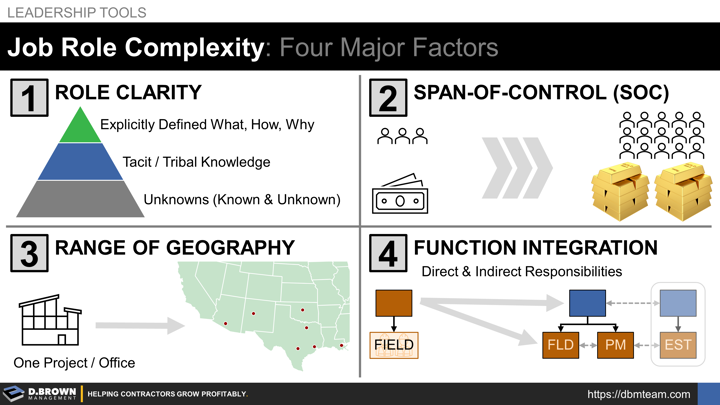There are fewer people as a percentage of the population that can do a more complex job role and those numbers will continue to decline through 2030 due to several trends including age demographics.
Understanding these four major factors will help with:
- Your strategic choices and business models.
- Your organizational structure design.
- Your job role design.
- Selection of the best candidate for the job role.
- Management of the person.
FOUR MAJOR FACTORS
- Role Clarity: This continually changes with headcount growth, moving from more generalized with more unknowns toward more specialized and explicitly defined. For example, a Vice President role at a Stage 4 contractor will have very little of the job role explicitly defined and there will be significant unknown unknowns for them and for their manager. By Stage 6+, that role will be much more explicitly defined including processes and standard operating rhythms for 60% or so of their work. This is about the same level of clarity that a Stage 5 contractor would have with their Project Managers.
- Span-of-Control (SOC): Quite simply, the more headcount and other resources (fleet, cash, etc.) the role is responsible for increases the complexity of the role. A General Superintendent with a 50-person or 150-person SOC are two very different roles and people, though there are a lot of similarities.
- Range of Geography: Managing 150 people on one project is different than managing 150 people across 15 projects that are all within about an hour's drive. That is completely different than managing those same people and resources across multiple states that makes regular touch points increasingly more difficult, whether it is jobsite visits or gathering everyone together for a meeting.
- Function Integration: Managing a team of 50 people across a single function like the field as a Superintendent is very different than managing that same quantity but across several functions such as an Operations Manager who may have direct responsibility for field and project management as well as indirect responsibilities to integrate with estimating.
Please keep in mind that hierarchies exist to enable people. Just because something seems perfectly clear at one level, don't assume that the same level of clarity will exist in the candidate pool for the job at different level.
As you grow the company, look at each job role and see if you can lower the complexity in some way through improving clarity, narrowing span-of-control, narrowing geography, moving the functional integration to a higher level, or a combination.
This is not "Dumbing Down" or "Hand Holding" which we hear a lot but rather effective delegation and creating the smaller steps necessary for more rapid career development with more people making it up the mountain.
Organizational Development requires as much discipline as planning project logistics including crane placement and each pick.

